Classroom Champions
From classrooms to government, Northwestern alumni are working to improve education in America
by Anita Cirulis
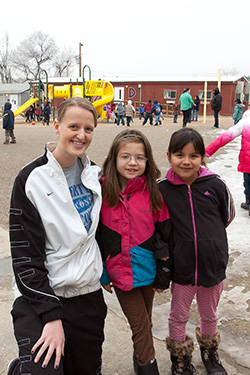
ANITA CIRULIS
Amy Kallemyn chose to teach at a school impacted by rural poverty when she accepted a teaching position on South Dakota’s Rosebud Indian Reservation.
Amy Kallemeyn ’11 strolls the schoolyard during recess as kids climb over the playground equipment at Rosebud Elementary. Nearby, three poles jut into the gray sky, devoid of ropes and tetherballs, while a half dozen children stand on a motionless merry-go-round sitting flush to the ground.
The merry-go-round, she explains, hasn’t worked since it was moved to make room for another modular classroom unit. Six such units, each containing two classrooms, fill half the playground space. They were added over the years when the original building, constructed in 1958, could no longer accommodate the growing number of students it serves.
Adding onto the school wasn’t financially feasible for the community of 1,500 on the Rosebud Indian Reservation in South Dakota. The average family income in Rosebud is less than $20,000, and 46 percent of children live below the poverty line. The school has no library, computer room or music room. Kallemeyn’s office is a storage closet she shares with the music teacher—as well as with a laminator, copy machine and shelves of paper.
Rosebud is a Priority School, the designation assigned to the nation’s lowest-performing schools by the No Child Left Behind (NCLB) Act of 2001.
“It’s a school in trouble,” Kallemeyn says. “Academically, kids aren’t reaching the standards. A lot of our kids have a really low reading level.”
Poverty, says Mike Hammer, Rosebud’s principal, impacts everything from attendance to a child’s home life. There are kids dealing with physical, emotional or sexual abuse, homes with 16 family members staying under one roof, and families living month-to-month on welfare or food stamps.
Kallemeyn, a 6-foot-2 former Raider basketball player, began teaching physical education at Rosebud in August.
“I was looking for someplace like Rosebud,” she says. A Human Relations course with education professor Jolynn Oliver opened her eyes to issues of racism and poverty. The following year she joined Oliver in teaching a month-long summer school for kids in Mendenhall, Miss.
“I just fell in love with it and knew that’s where I wanted to be,” she says about teaching disadvantaged children. “South Dakota gets a bad rap for teacher pay and not having good enough teachers, so I felt like I should go there.”
Missing the Mark
The public school system in the United States was founded on the belief that an educated citizenry is a common good, essential for the health of the country and a key to a better life. The nation’s schools Americanized immigrants and prepared a workforce that gave the U.S. the strongest economy in the world.
It’s understandable, therefore, that perceived failures in America’s schools have been seen as a threat to the United States’ well-being and future. In 1957, fear caused by the Soviet Union’s launch of the Sputnik satellite led to passage of the National Defense Education Act, which marked the beginning of the federal government’s involvement in providing funding for K-12 schools.
Four decades later, Congress passed No Child Left Behind, tying federal school funding to the administering of statewide standardized tests. The act was a response to two achievement gaps—one international and one domestic.
Internationally, American students are consistently outperformed by students from other countries on comparative tests such as the Programme for International Student Assessment (PISA). In the most recent PISA results, out of 34 countries, the U.S. ranked14th in reading, 17th in science and 25th in math.
Domestically, the gap is most obvious in differences in test scores and high school graduation rates between inner-city minority students and students living in the suburbs. Such differences, says Dr. Yong Zhao, an author and expert on the implications of globalization on education, are evidence of education inequalities stemming from “poverty, funding gaps and psychological damages caused by racial discrimination.”
“If you look at the No. 1 correlation between test scores and any other factor, it’s socioeconomic status,” says Laura Heitritter ’84, co-chair of Northwestern’s education department. “Poor kids live with a lot of different stressors—economic, family—that produce physical changes in their brains and impact their learning.” The United States has a relative child poverty rate of 23 percent, the second highest among developed nations.
Poverty also impacts schools in terms of facilities, supplies and teachers.
“Our education system is mostly dictated by ZIP code,” says Dr. Derek Brower ’89, assistant professor of education at NWC. “That’s what determines the quality of schools.”
In other words, with public schools funded by property taxes, affluent suburbs have more to spend on each student than poor, inner-city neighborhoods. When education activist Jonathan Kozol wrote his book Savage Inequalities, total yearly spending in Illinois ranged from $2,100 on a child in the poorest district to above $10,000 in the richest. He vividly describes the impact of such disparities as he tells of schools where heating and cooling systems don’t work properly, closets have been turned into classrooms, rain leaks through roofs, and students lack textbooks.
Some states—like Iowa—have funding formulas that prevent such huge disparities, but taxpayers can still vote for tax levies for their school districts to provide additional money for instructional support, buildings and equipment.
“Orange City has great funding for its schools; other area schools don’t have that,” says Heitritter. “It used to be that Iowa had pretty good per-pupil equity. That’s not the case anymore because of all the ways we can vote to tax ourselves. Some would question what’s wrong with funding our schools more if that’s what we want to do. I understand that, but if neighboring communities don’t or can’t, those kids are at a comparative disadvantage.”
Brower points out one result of such funding differences: “If I’m a teacher and I have the choice of teaching at a school that pays more, I’m probably going to choose the school with the higher salary.” Schools with better salaries, facilities and equipment not only enjoy a better selection of teacher candidates due to more applicants, but they also draw good teachers away from lower-paying districts. “So the poorly funded schools have more teacher turnover, and teacher turnover hurts students,” he says.
Inner-city Teaching
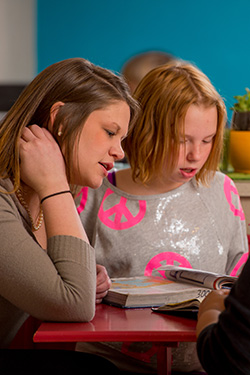
GREG LATZA
After teaching three years at an inner-city school in Detroit, Jessi Mattson returned to her hometown to open Powerhouse Tutoring Center, a ministry sponsored by two Sioux Falls churches.
Some of the nation’s worst schools are in Chicago, where drop-out rates range from 50 to 60 percent. Northwestern students wanting an inner-city teaching experience can enroll in the Chicago Semester, which combines classes on Christian social values with urban internships.
Jessi Matson ’07 enrolled in the program after attending a Christian Community Development Association (CCDA) conference as a sophomore in college. She did her student teaching in Chicago in a school that served primarily Hispanic children.
“There were security guards and police officers at the door and teachers had to wear a uniform,” she says. “There was no recess and there were no supplies and there were no specials (art or music classes). It was just like what you see on TV but don’t think is true.”
Matson was assigned to a class of 29 first graders “stuffed” into a small room.
“The teacher I taught under had been there for years and was just doing what she had to do to get by. As a student teacher, we had to write crazy amounts of lesson plans. I don’t think I saw her write one lesson. I just saw her open up the teacher manual and read what was there and teach off of that. There were some teachers that were exceptional and some that were passionate about what they did, but for the most part, it was a good learning experience for what not to do.”
Following graduation, Matson moved to Detroit to work with a ministry called City Mission that she learned about at the CCDA conference. The Christians who founded City Mission had left the suburbs to live in a black inner-city neighborhood where they ran after-school tutoring and mentoring programs. In 2007 they started a school, and Matson was hired as one of its teachers and assigned a class of 11 second and third graders.
“The first week I cried every day because it was hard and they were hard kids. They come from backgrounds where they have to fight to survive,” she says. “I thought to myself, ‘This is so out of my league. What am I doing here?’ But as time went on, I fell in love with those kids.”
Living in the neighborhood, Matson was able to build relationships with the children and their families. She would knock on their doors when they didn’t come to school and care for kids on the weekend when their moms needed help. In turn, they were her friends, kept an eye on her house, and watched her back. “It was a really beautiful picture of how to do education,” she says.
When the recession hit in 2009, funding for City Mission Academy dried up. Many of the school’s donors were executives and employees of Chrysler and General Motors, which were going bankrupt. Faced with the loss of her job, Matson moved back to her hometown of Sioux Falls, S.D., where her church, Hillcrest, had been supporting her during her years in Detroit.
With Hillcrest’s help—and in partnership with Wesley United Methodist Church—she launched the Powerhouse Tutoring Center. The center is located in a low-income neighborhood in northeast Sioux Falls, where much of the city’s immigrant, refugee and Hispanic populations reside. As in Detroit, Matson lives where she works: Her home is upstairs—and the tutoring center, downstairs—in a former church parsonage.
“The similarities between Detroit and Sioux Falls are amazing,” Matson says. “The kids are so capable, but they have such hard stories in life that they can’t put aside so they can work on their academics. If they don’t find something to cling to and someone to motivate them, they’re not going to succeed.”
A Different Model
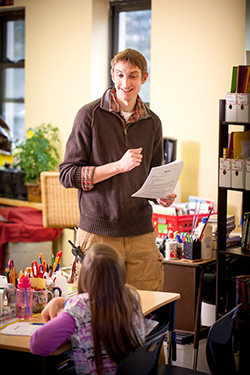
BILL SAWALICH
Chris Rensink teaches at a church-sponsored school in St. Louis that serves a large refugee and immigrant population.
The closing of City Mission Academy impacted another Northwestern grad. Chris Rensink ’07 taught fourth through sixth graders at the Detroit school for a year and still remembers the challenges he faced.
“I had never experienced a fight in my classroom before,” he says. “I was stunned my first week of teaching during a social studies lesson when the students didn’t even recognize where the United States was on a globe.”
Most of Rensink’s students were two years behind their grade level when he started teaching them. By the end of the year, they had nearly closed that achievement gap—a perfect example of what experts say is the impact an individual teacher can have on a group of kids. “The difference between a really good teacher and a really bad teacher is one year of learning per academic year,” says Stanford University’s Dr. Eric Hanushek, an expert on educational policy and the economics of education.
Rensink now teaches at the Freedom School in St. Louis, a nonprofit ministry of New City Fellowship Church and Restore St. Louis. The school serves 140 students—many of whom are immigrants and refugees—charges tuition based on what people can afford, and partners church members with families served by the school. So successful is the Freedom School that it has a waiting list of students, and residents of St. Louis are asking the church to replicate the school in other parts of the city.
Waiting lists of students are an issue faced by charter schools as well as privates. First established in the early ’90s, charter schools are designed to be autonomous public schools—forgoing a portion of their funding for greater flexibility—that students attend by choice rather than because of where they live.
Enthusiastically embraced by education reformers, charter schools were supposed to improve public schools by giving them competition for students. However, a national study in 2009 conducted by Stanford University found that students in most charter schools performed no better than those in traditional public schools.
Voucher programs have proven similarly disappointing. A 2007 report of the federal National Assessment of Educational Programs found that, 20 years after the initiation of vouchers in Milwaukee, there was “no evidence of dramatic improvement for the neediest students or the public schools they left behind,” says Dr. Diane Ravitch, an educational policy analyst and research professor at New York University.
Ravitch now believes that, by drawing the best teachers and most motivated students out of our nation’s schools, charters threaten what was once America’s “democratic vision of public education.”
Outcomes Matter
What is evident is that there are no quick fixes for failing schools in America. The United States is a huge, complex nation, ethnically diverse and polarized politically. Efforts at reform are constrained by education policies, bureaucracy, laws and teachers’ unions.
It’s also a nation with a utopian view of what schools should be like, says Heitritter. “We don’t want failure. We’ve always said every kid deserves a good-quality education. A lot of countries don’t have that. They sort and select from the very beginning.”
For Mike Siebersma ’00, a school improvement consultant, that perspective is a strength of No Child Left Behind. Siebersma serves as a deputy director at Education Northwest, an educational research, development and training firm based in Portland, Ore.
“For all its faults, I believe No Child Left Behind had a positive impact because it got people to start paying attention to all kids due to the idea of subgroups needing to make progress,” he says. He gives as an example a school where 80 percent of its students are privileged, middle-class kids and 20 percent are minority or second-language learners.
“An aggregate score might show 80 percent of the kids proficient, but when you look into the numbers, you might discover that all the middle-class kids are achieving and 100 percent of the poor kids are not. Those kinds of things became much more difficult to hide with No Child Left Behind. People started accepting the idea that outcomes matter.”
Siebersma’s commitment to equity began when he served two years as a principal for a middle school in eastern Iowa.
“It was a school that was really comfortable,” he says. “They felt like they were doing well, but they had ignored the early years of accountability and weren’t focused on student outcomes.”
Historically, the school’s principal was seen as a disciplinarian and building manager. Siebersma’s priorities were student achievement and high-quality instruction. Under his leadership, professional development became “intensive, job-embedded, accountable learning” that teachers were expected to apply, and the school’s culture changed to one that valued literacy and reading.
Wanting to make even more of a difference, Siebersma joined Mid-continent Research for Education and Learning (McREL), a well-known private, nonprofit organization that helps schools raise student achievement. His work took him all over the world, from northern Quebec to Guam to school districts across the United States.
A major criticism of No Child Left Behind is its emphasis on test scores and the negative impact that emphasis has had on teaching and learning. Siebersma admits NCLB has its weaknesses.
“Schools became test prep factories and showed big gains on tests,” he says. “Meanwhile, they didn’t equip students to learn how to learn and to be creative. They also killed teacher learning with some of those practices. I’m a person who makes a living off of promoting teacher learning and professional development for educators. If we’re not focused on teachers getting better at their craft, then that’s a really ugly phenomenon.”
Siebersma is excited about a grassroots movement called the Common Core State Standards Initiative being developed by the Council of Chief State School Officers. Determining what students should learn and be able to do will enable schools to focus on the right practices and how best to measure that learning, he says.
For Siebersma, test scores, while important, are a “lagging indicator” of a school’s progress. More important are leading indicators like classroom practices—as well as a willingness to give change time to happen.
“I often see schools take on these ambitious initiatives, never really do them well, and then conclude early on they didn’t work before they move on to the next thing,” he says. “A lot of my work over the last several years has been trying to get people to sustain change—to take manageable bites of change, do them well, learn from them, and then take the next step.”
Advocating for Reform
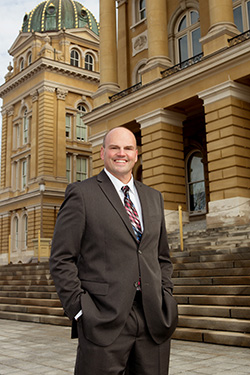
LON MONAHAN
As chief administrator for Iowa’s Prairie Lakes Area Education Agency, Jeff Herzberg serves on a number of statewide committees and meets regularly with lawmakers in Des Moines about issues in education.
While not a member of the Council of Chief State School Officers, Jeff Herzberg ’88 is involved in a number of statewide task forces and committees and regularly travels to Des Moines to meet with Iowa legislators about issues in education. As chief administrator for the Prairie Lakes Area Education Agency, he helps lead an organization responsible for 30,000 students in 44 public school districts and 12 private schools.
“The focus on testing has corrupted our schools in terms of what we should be doing to prepare kids for the 21st century,” he maintains. “Instead of standardized tests in basic subject areas, we should figure out how to assess problem solving, critical thinking and collaboration, which are the workplace and societal skills needed today.”
Herzberg serves on the governor’s STEM Advisory Council, which is charged with improving education in science, technology, engineering and mathematics, as well as on Iowa’s Competency-Based Education Task Force.
“I do think we’re getting closer to real systemic change in Iowa and in our schools because people have seen the impact of not staying current and not changing the way we educate our young people,” he says.
Among educational reforms advanced by Iowa’s Gov. Terry Branstad are proposals to increase starting teacher salaries to $35,000; provide tuition reimbursement for top students who commit to teach in Iowa for five years; give first-year teachers a reduced teaching load so they can spend more time learning from outstanding veteran teachers; and pay those veteran teachers more for leading and mentoring their peers.
Those who want to teach in Iowa must now pass two licensure exams, one in content and the other in pedagogy. The state is also moving to an internship model for teaching that requires education majors to complete a yearlong student teaching experience.
Northwestern’s education professors view as a sacred trust their role in preparing excellent teachers. Prospective education majors are introduced to the classroom early, and methods classes are designed to give students the opportunity to practice educational theory while they are learning it. As an NCATE-accredited program, Northwestern requires students to pass through multiple “gates” while providing them with constant feedback.
“As we’re evaluating students for the program, we ask, ‘Do I want this person teaching my children?’” says Brower. He and his colleagues consider each candidate’s content knowledge, performance and disposition before approving them for student teaching.
“Our model is ‘Teacher as Servant,’ and that’s borne through in what we do as preparation for our students,” Heitritter says. “We know they can serve society and serve Christ by serving kids, and we’re unapologetic about that.”
One Child at a Time
While educational reform is important, ultimately it’s up to each individual teacher to connect with, motivate and inspire his or her students. Amy Kallemeyn admits if it weren’t for her faith, she wouldn’t last where she’s chosen to teach.
“I already have kids asking me if I’m going to stay for next year, because they just expect you to leave,” she says. “I tell them, ‘Oh, yeah. You’re stuck with me.’”
Asked what motivates her, she chokes up and struggles to get out the words.
“It’s that moment when a kid smiles at you or starts laughing at something silly or because they’re enjoying a game—that pure laughter that maybe doesn’t happen at home,” she says through tears. “It’s all about the kids.”
Northwestern alumni who choose to teach recognize they may not be able to fix what’s broken about America’s educational system—though some are trying—but they can make a difference in an individual child’s life.
And that’s a start. 
 In classrooms, school offices, research centers and government, Northwestern alumni are working to improve education in America.
In classrooms, school offices, research centers and government, Northwestern alumni are working to improve education in America. No longer taboo, tattoos mark what’s important to
students, including their faith.
No longer taboo, tattoos mark what’s important to
students, including their faith.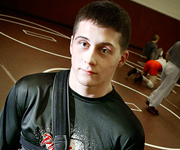 Double-leg amputee Preston Hoebelheinrich thanks
God every time he steps onto the wrestling mat.
Double-leg amputee Preston Hoebelheinrich thanks
God every time he steps onto the wrestling mat.
Classic Comments
All comments are moderated and need approval from the moderator before they are posted. Comments that include profanity, or personal attacks, or antisocial behavior such as "spamming" or other inappropriate comments or material will be removed from the site. We will take steps to block users who violate any of our terms of use. You are fully responsible for the content that you post. Comments posted do not reflect the views or values of Northwestern College.